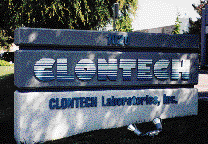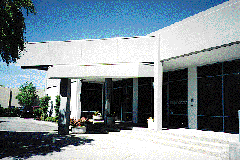GOLDSEA | ASIAMS.NET | ASIAN AMERICAN PERSONALITIES
DR DNA
PAGE 2 of 7
PhDs account for 45 of its 230 employees--an unusually large number for a mid-sized biotech firm. Most of these PhDs work at lab benches to research and develop tools to address current and anticipated needs of leading-edge molecular biology researchers. The rest answer 8,000 technical calls each month from client labs concerning research procedures related to Clontech products.
| "We're like Intel." |
To keep Clontech out front Fong's eyes stay on the dizzying curves rushing up in the molecular biology field. The next big development, he expects, will come from using comprehensive gene maps to facilitate preventive medicine by detecting genetic predispositions to diseases. Along these lines biochips are the next big thing in both laboratory and clinical research applications. The forerunner in this trend is the GeneChipTM introduced last year by 6-year-old Santa Clara-based Affymetrix. Using lithographic processes developed for the semiconductor field, Affymetrix laid down 100,000 distinct DNA pieces on a single half-inch-square chip. These GeneChips--generically called high-density oligonucleotide probe arrays--can signal the existence of known and mutant sequences when immersed cDNA pools, cell lines or tissue samples. Because they can simultaneously scan for huge amounts of genetic information rather than a few strands at a time, these biochips promise to shoot medical and pharmaceutical research to a whole new level. What all this means for a company like Clontech is the need to rethink its mission. The threat to its current business, however, isn't immediate. During the entire first quarter of 1997 Affymetrix sold only about $450,000 worth of biochips to labs, compared with about $9 million in sales of Clontech's more conventional research tools. It will likely be three to five years before Clontech's client labs start using biochips to conduct significant numbers of research tasks.
Fong welcomes the biochip challenge. About a year ago Clontech began developing its own homegrown technology. It has succeeded in laying down 5,000 individual genetic compounds on a single tiny swatch of membrane. Within two years Fong hopes to raise the density to the 100,000 level and transfer the array to a chip format.


"It's the big revolution of the biotech field," Fong says with some excitement. So while taking a dim view of the prospects for immortality, he does see solid prospects for 150-year lifespans. With tools provided in part by Clontech researchers around the world are well on the road to mapping the 70,000 to 100,000 genes that comprise the human genome. Experiments have succeeded in increasing by as much as 50% the lifespans of fruitflies and worms which share thousands of genes with humans.
"By 2003 we might have figured out the functions of half of them," Fong says. "One could prove to be a longevity gene. Or there might be a multiple of genes responsible for longevity."
But experiments have repeatedly shown that cells in human tissue reach senescence and stop replicating after a fixed number of cell divisions, Fong cautions. PAGE 3
Page 1 |
2 |
3 |
4 |
5 |
6 |
7 |
CONTACT US
|
ADVERTISING INFO
© 1996-2013 Asian Media Group Inc
No part of the contents of this site may be reproduced without prior written permission.
